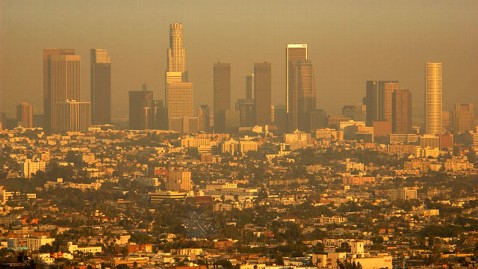Los Angeles Tops 'Dirty Air' List for 13th Time in 14 Years
Thanks to the Clean Air Act, a lot of people in the United States are breathing a little easier. The American Lung Association's "State of the Air 2013? report, which analyzed ozone and particle levels in the air from 2009 to 20011, showed that the nation's air quality is overall much cleaner, especially compared to a decade ago.
Still, the report found that more than 131.8 million people - 42 percent of the nation - live where pollution levels often make breathing a hazardous activity.
Nearly 120 million people live in areas with unhealthful levels of ozone, putting them at risk for premature death, aggravated asthma, difficulty breathing, cardiovascular harm and lower birth weight, the report revealed. The actual number who breathe unhealthy levels of ozone is likely much larger, since this number doesn't factor people who live in adjacent counties in metropolitan areas where no monitors exist.
Car-obsessed Los Angeles once again tops the list for the worst ozone pollution in the country for the 13th time in the 14 years the report has been issued. Californians, in general, tend to inhale the dirtiest air: seven of the top-10 most air polluted cities on the list are in that state.
 L.A. has worst ozone. (Image Credit: David McNew/Getty Images)
L.A. has worst ozone. (Image Credit: David McNew/Getty Images) Houston, Dallas and Washington, D.C., round out the top 10 for dirtiest air.
Although the worst offenders tended to be repeats from the 14 previous reports, there were a few surprises.
"One of the concerns we saw in this year's report was the increase in unhealthy ozone days in the middle part of the county," noted Janice Nolen, assistant vice president of national policy for the American Lung Association. "This smog spike in smaller cities in particular may be related to increased heat in the summer and to the growth in oil extraction."
Four cities - Bismarck, N.D., Cape Coral-Fort Myers, Fla., Palm Bay-Melbourne-Titusville, Fla., and Rapid City, S.D. - were noted for having the cleanest air overall, meaning they reported no days at the unhealthy level for ozone, short-term particle pollution or year-round particle pollution.
The majority of cities that topped the list for lower ozone pollution, lower particle pollution or both, tended to be in the western part of the country in states like Colorado, Arizona and Utah. But Bangor, Maine, enjoyed low levels for both year-round and short-term particle pollution, and Burlington, Vt., topped the list for lightest ozone levels and year-round particle pollution.
One lone city from the Deep South, Muscle Shoals, Ala., was singled out for low levels of ozone and short-term particles.
Even in the cities with the filthiest of air, there are some glimmers of fresh oxygen through the smog. Fifteen of the 27 cities with the most ozone pollution improved their air quality in the previous year. And 13 of the country's most smog-polluted cities experienced their best year yet.
Unfortunately, even with the improvements, people living in the most pollution-choked areas are still breathing air that reaches dangerously unhealthy levels.
Want to know where your city ranks on air quality? Click here for the full report.